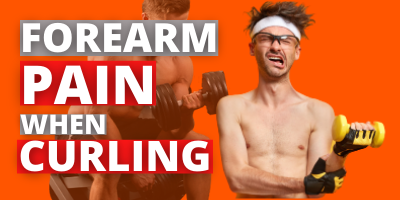Forearm pain when curling? 3 reasons why!
Are you noticing forearm pain when bicep curling?
In this blog we will be giving you three reasons why you may be experiencing pain in your forearm when you curl, as well as 3 things you can do to help with the pain!
Why you may be experiencing forearm pain during a bicep curl!
- Tight and tense forearm muscles
Tight and tense muscles are a big contributing factor to pain in our forearms when curling. The muscles in our forearm can become more tense and even tighter when we curl.
This tightness then refers a pain sensation to our brain. It is our bodies way of telling us that our muscles are tight and we need to do something about it.
This tightness and tension can sometimes compress nerves in our forearm which can then refer a shooting or burning sensation during our curl.
- Not warming up
When you exercise without a warm up it can often impact how our muscles feel. If our muscles are tight and tense and we go straight into doing a bicep curl, this can sometimes cause pain as our muscle are not yet warm enough or ready to perform this movement.
A warm up allows blood flow to get to the muscles, helping to prepare them for the exercise we are about to do. Warm ups have many benefits, including: Reduce injury risk, preparing your muscles, increase body & muscle temperature, reduce muscle tension, increase blood flow and oxygen and more!
- The weights are too heavy
We all want to push ourself that little bit extra when curling. Especially as we approach summer and we want to get our t-shirts to hug our biceps, showing off our “guns”.
However, we shouldn’t be causing ourself pain to get there.
Part of your forearm pain when curling could simply be because you are trying to lift weights that are too heavy for you.
There’s no shame or embarrassment in not being able to lift the weights we want to and although it’s good to challenge ourselves, we shouldn’t be curling weights that are too heavy for us, ESPECIALLY if it causing pain!
So remove the ego, take a step back to analyse the weights you’re lifting, and reduce the weights if they’re too heavy.
How to reduce your forearm pain when curling?
Before we start, it’s always best to seek the advice of a health professional before trying anything on your own. Having said that, here are three things you can try, in order to help reduce your forearm pain when curling.
Sports massage is a great way to reduce the tightness and tension in our muscles to help reduce our pain and discomfort. Sports massage uses a range of techniques to break down tightness, restriction and tension in our muscles.
Getting a sports massage which specifically targets the forearms is a fantastic way to help reduce the tightness that is very possibly causing the pain when you curl.
A sports therapist, sports rehab therapist, physical therapist, sports physio, sports massage therapist are all great people to see and a professional will offer additional advice specific to you and your pain.
Remember, it’s always best to see a professional where possible.
As we mentioned earlier, your forearm pain may be due to tightness and another way to help reduce that tightness is through stretching.
When we stretch our forearm it can help to reduce the tightness that may be causing the pain when we curl.
Stretching has so many benefits, including: preventing injury risk, increasing range of motion, decreasing pain, reducing DOMS, relaxing our muscles and more!
If you’re not stretching prior to your bicep curl, this could be a reason why you’re experiencing pain
Now, when you stretch, it’s important to hold the stretch for at least 30 seconds to get the full benefit of the stretch.
Not sure how to stretch the forearm? Check out our blog here!
A trigger point ball is a firm ball which is roughly the size of a tennis ball.
Trigger point balls can be used to break down tension, tightness and restriction within our muscles.
Check out the video below to see how we can reduce our tension with this little piece of equipment.
Want tips on reducing pain and improving your muscles, why not subscribe to our YouTube?

